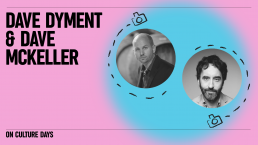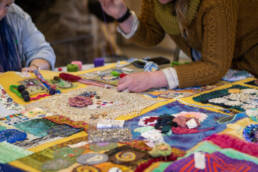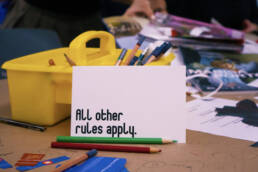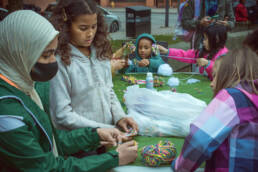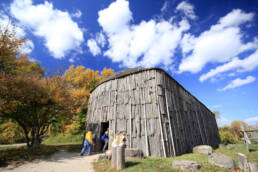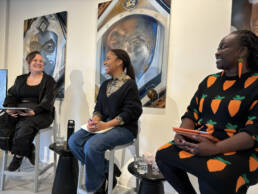Watched “Last Night” and wanted to check out more films?
Check out Dave Dyment’s watchlist below!
To read Dave Dyment’s summary of Last Night, visit here.
Other projects by Don McKeller and cast
BLUE.
Don McKellar. 1992
The IMDB page gets cast and crew details correct about Don McKellar’s debut, but the blurb for the short film reads:
“Blue, Not Just a Color Anymore! Blue’s the Friend Everybody Would Love to Have. He’s a Floating Blue Ball of Unknown Energy, and He can morph into Anything he Wants! from an Apple Ipod to a Zurich Made Watch and Everything in Between!”
The error is perpetuated on countless other film sites which clearly scrape IMDB for data without checking the veracity of the information.
The film – which I first saw on a double bill with Penelope Spheeris’ Banned in the USA – features David Cronenberg playing a carpet salesman with a porn addiction. Tracy Wright plays his shy co-worker, roles they re-inhabit in Last Night.
“Blue is slightly dirty, so it didn’t get a lot of TV play,” McKellar said. “David plays a porno addict who works in a carpet factory, and a day in his life is intercut with this porno film I shot. He’s a really great, charming person and his persona is an important character type to me, this real Toronto persona – soft-spoken, articulate, always in control.”
THE ADJUSTER.
Atom Egoyan. 1991
The first Egoyan film I saw remains my favourite. The Sweet Hereafter, released six years later, is probably the greater achievement, but this story of an insurance adjuster is more oddly compelling. McKellar and long-time Egoyan partner and collaborator Arsinée Khanjian both portray employees of the Censor Board.
TWITCH CITY.
Bruce McDonald. 1998 – 2000
McKellar’s character also never goes outside in this CBC sitcom directed by his long-time collaborator Bruce McDonald. Curtis is an agoraphobe living in Kensington Market who watches an obscene amount of television.
In the sitcoms of my youth, living rooms always looked wrong because they almost never had a television set. Or if they did, it was brought out from behind a side table on the rare times that the characters were needed to be seen watching TV. I think Married With Children was the first time a sitcom living room seemed arranged around a television set.
McKellar stated that the impetus for this project was the desire to make a sitcom with “a couch against the wall,” instead of in the middle of a living room.
Curtis is a hipster bohemian slacker but also a cutthroat entrepreneur, subletting out every possible square foot of his small Kensington Market apartment to reduce his own rent. The series opens with his roommate accidentally killing a homeless man (played by King of Kensington star Al Waxman, in a bit of patricidal casting) and hauled off to prison. Curtis rents out his room and tries to seduce his girlfriend, played by Molly Parker.
The cast also includes Daniel MacIvor, Callum Keith Rennie (from Last Night) and Bruce McCulloch and Mark McKinney from The Kids in the Hall. Guest stars on the series included Tracy Wright, Jennifer Jason Leigh, Tom McCamus, Valerie Buhagiar, Hugh Dillon, and Three’s Company’s Joyce DeWitt, playing herself.
It’s my favourite Canadian sitcom of all time (perhaps tied with Ken Finkleman’s Newsroom).
ME AND YOU AND EVERYONE WE KNOW.
Miranda July. 2005
Miranda July’s first feature film remains her best known and most celebrated work. July reportedly cast Tracy Wright in the role of the curator after seeing her in Last Night. She is responsible for the most poignant moment in the film – when she learns the man she has been exchanging intimate texts with is actually a young boy.
WAYDOWNTOWN.
Gary Burns. 2000
Set in Calgary’s +15 skyway system (like Toronto’s PATH system, but mercifully above ground), this film stars Fabrizio Filippo and Don McKellar in a story of office workers who bet a month’s wages over who can stay indoors the longest. The best Calgary film that isn’t FUBAR.
KILLING EVE.
Phoebe Waller-Bridge. 2018 – 2022
Killing Eve is a British spy thriller television series which follows MI5 agent Eve Polastri (played by Sandra Oh), who is tasked with capturing psychopathic assassin Villanelle (Jodie Comer). It was adapted by Phoebe Waller-Bridge, fresh off her excellent sitcom Fleabag, and became the most talked about show that year. Oh won multiple best actress awards, cementing her status as one of Canada’s most celebrated actors. She became the third Asian woman to host SNL (and the first Asian Canadian), the first Asian woman to host the Golden Globes and in 2019 Time Magazine listed her as one of the 100 Most Influential People in the world.
TAKE THIS WALTZ.
Sarah Polley. 2011
When I first watched this I hated every minute of the first third, and nearly turned it off. Too many over-played Rom Com tropes and a ridiculous amount of serendipity fuelling the set-up – I was mostly cringing.
But it began to get under my skin and I found myself thinking about it for weeks afterwards. I realized that I had never seen a movie in which a woman leaves a man who isn’t a complete asshole. Or cheats on a man who isn’t first cheating on her (even if she doesn’t know, the audience has to). We typically have to be shown him kicking a dog or hating her children. Never just that she’s a little bored with her life and looking for some excitement or distraction. Polley casts the perfectly charming Seth Rogen in the role of the dumped boyfriend, further complicating our allegiances.
Also, the use of the Buggles song “Video Killed the Radio Star” rivals almost any other use of a pop song on a film soundtrack. It plays first during a scene on a fairground ride at Centre Island and my enthusiasm extends far beyond simply remembering riding the same ride to the same song, years ago.
The song is so lyrically specific and already carries some visual baggage (it was famously the first music video played on MTV, when it launched in 1981). But it works despite itself. Lines like “I can’t rewind I’ve gone too far” resonate with the characters in almost profound ways.
My friend Carl Wilson described it as “the film and the song begin singing questions into each other’s mouths.”
Other Toronto films
I LOVE A MAN IN UNIFORM.
David Wellington. 1993
Named after a 1982 Gang of Four song, I Love A Man In Uniform stars Tom McCamus as a bookish bank employee and struggling actor who gets cast as a cop in the television police drama, Crimewave. He immerses himself in the role, and takes to wearing the uniform out around town after hours, blurring the line between actor and character.
Unable to distinguish between one reality and another, it’s not difficult to read the character and his new sense of pride while donning the uniform as a stand-in for the city.
Bringing everything full circle, Wellington later directed several episodes of the police drama Rookie Blue, which I suspect might somewhat resemble the type of show his feature debut parodied.
VIDEODROME.
David Cronenberg. 1983
Cronenberg began filming his eighth feature film exactly forty years ago, to the day (October 19, 1981). Funding always came late in the year, he notes in the Criterion Collection director’s commentary, so Canadian movies were shot in the cold fall, with little light.
The film follows the CEO of CIVIC TV (a clear parody of Toronto’s City-TV channel, then known for airing blue movies in the middle of the night) who stumbles upon a broadcast signal featuring violence and torture. While attempting to uncover the source, he loses touch with reality and experiences a series of increasingly bizarre hallucinations.
I’VE HEARD THE MERMAIDS SINGING.
Patricia Rozema. 1987
Rozema’s debut feature film was the first English-language Canadian film to win an award at the Cannes Film Festival, where an audience of two thousand gave the film a six minute standing ovation.
Sheila McCarthy stars as Polly, who Rozema describes as functioning as a stand-in for Toronto: “She’s quiet, very funny, insecure and visionary, which is how I saw our city at the time.”
The film features the Royal Bank plaza, the CN Tower and other notable Toronto landmarks.
“I learned from making shorts that you film stuff and then it goes away – people take down buildings all the time,” Rozema told NOW magazine. “So as a filmmaker, you’re not just a storyteller, you’re recording a place.”
The film is often cited as using magic realism to break free from the documentary style of cinema most Canadian features were rooted in (see below).
YOU ARE HERE.
Daniel Cockburn. 2010
Influenced by authors Paul Auster and Jorge Luis Borges, and directors Todd Haynes and Charlie Kaufman, You Are Here follows a woman (Tracy Wright) searching for the meaning behind a series of audiovisual documents from other universes. Wright was McKellar’s partner and appeared in many of his films. She died of cancer seven weeks before this film was released.
“It feels almost gauche to say, ‘Oh, well, she’s not here, but at least we have her performances,’ but it’s true,” Cockburn told Norm Wilner in 2010. “Pieces of people are present in their performances, and because she was such an honest person and an honest performer, her performances really are pieces of herself. I would never say they could stand in for the person, but they are reminders of how genuine she could be in life and in performance.”
Shot entirely in Toronto, Cockburn deliberately complicates the city’s geography with invented street names and numbers.
“I don’t want to say that Toronto is devoid of globally recognizable cultural and architectural landmarks,” said Cockburn. “But if you want to make a movie that’s spatially anonymous, it’ll work for you, ”
ENEMY.
Denis Villeneuve. 2013
An international production with stars like Jake Gyllenhaal and Isabella Rossellini, Enemy is not only set not only in Toronto, but in Mississauga, also. I grew up in Mississauga and never once saw my ‘city’ represented in cinema (though the terrible 1988 horror film The Brain was filmed at my high school).
Villeneuve’s films are almost all worth seeing, but this one (another case of mistaken identity) can also be read meta-textually, about Toronto.
An Indiewire review compared the film to Christopher Nolan’s Memento (which, incidentally, featured Callum Rennie from Last Night), and called it an “engrossing Kafka-esque provocative psychological thriller” that “doesn’t reveal itself easily”. It was also compared to the films of David Lynch, whose Dune Villeneuve has just remade. It opens Friday.
RUDE.
Clement Virgo. 1995
The first Canadian feature to be written, produced, and directed by an all-black crew, Rude addresses themes of sin and redemption. The film presents three interrelated stories about Black Canadian life in the “projects” of Regent Park, shot in three distinct styles, taking place over Easter weekend.
The title character, a pirate-radio DJ, broadcasts across the city “like a mother lion watching over her cubs”. Rude won eight Genie Awards, including best picture and best director for Virgo.
GOIN’ DOWN THE ROAD.
Donald Shebib. 1970
The classic SCTV sketch Garth & Gord & Fiona & Alice opens with John Candy trying to convince Joe Flaherty to abandon the surgery he is about to perform so they can begin their road trip together.
“Oh Gord, you’re going to love it in Toronto, they got roads and everything, all kinds of roads,” he says. “And jobs, too?” “All kinds of jobs – doctoring jobs and lawyering jobs, jobs for me and you!”
They head off to the big city in a convertible with “My Moncton Home” spray-painted on the side. En route they meet a hitchhiking francophone Nuclear Physicist who is also headed to Toronto in the hopes of making her dreams come true. When they arrive they do not find the work they were promised, but spend their time instead cruising Yonge street and the big box record stores of the time, Sam the Record Man and A&A’s.
The parody doesn’t stray too far from the original, in which two Cape Breton Islanders drive their 1960 Chevrolet Impala (“My Nova Scotia Home” painted on its side) in search of love and vocation. Jayne Eastwood even reprised her role as the pregnant girlfriend from the original.
Shot in a near-documentary style on a shoestring budget, Goin’ Down the Road is often considered one of the country’s greatest films ever produced.
Also
PICTURE DAY. Kate Melville. 2012
EMPZ 4 LIFE. Allan King. 2006
WHEN NIGHT IS FALLING. Patricia Rozema. 1995
THE SILENT PARTNER. Daryl Duke. 1978
HEAVEN ON EARTH. Deepa Mehta. 2008
OUTRAGEOUS! Richard Benner.
1977 THE FIVE SENSES. Jeremy Podeswa.
1999 MONKEY WARFARE. Don McKellar. 2006.
End of the world cinema
THE SACRIFICE. Andrei Tarkovsky. 1986
THIS IS THE END. Seth Rogen & Evan Goldberg. 2013
CONTAGION. Steven Soderbergh. 2011
IT’S A DISASTER. Todd Berger. 2012
CHILDREN OF MEN. Alfonso Cuarón. 2006
ARRIVAL. Denis Villeneuve. 2016.
SEEKING A FRIEND FOR THE END OF THE WORLD. Lorene Scafaria. 2012
28 DAYS LATER. Danny Boyle. 2002
LA JETEE.
Chris Marker. 1963
This 28-minute film told almost exclusively with still photographs and voice-over narration is basically about a boy forced to witness his own death over and over and over again. Terry Gilliam remade it into one of his more successful films,12 Monkeys, which itself was later made into a television series. I never saw the latter, though it was filmed in Toronto.
DR STRANGELOVE.
Stanley Kubrick. 1964
A dark comedy that ends in annihilation might not have seemed like a recipe for box office success at the height of the Cold War. The first planned screening of the film was scheduled for November 22, 1963, the day that John F. Kennedy was assassinated in Dallas. The film was delayed until January of the following year and the Slim Pickens line “a fella could have a pretty good weekend in Dallas with all that stuff”, was changed to “Vegas” in post-production.
The film became an enormous success and is typically heralded as the greatest comedy of all time, (and sometimes the greatest film of all time). It is director Stanley Kubrick’s highest rated feature.
The closing montage of nuclear explosions accompanied by Vera Lynn singing “We’ll Meet Again” (reportedly at the suggestion of Spike Milligan) is sublime.
UNTIL THE END OF THE WORLD.
Wim Wenders. 1991
On the strength of Wim Wenders’ Wings of Desire, I dragged about a dozen friends to the cinema, to see his 1991 follow-up. Some were cinephiles, some were not. At one point or other in the 179-minute running time (a new Director’s cut manages to add another 108 minutes) each of us wanted to leave. Someone would stand up assuming the rest would follow, but each time there was a hold-out. My friend Chris was a Bergman fan, so he wanted to stay to see Max Von Sydow, for example. By the time he was bored or frustrated or both, and was ready to leave someone else had caught a glimpse of something that captured their imagination. I remember each of us ready to walk out at one point and yet we all stayed until the end.
The film is essentially three different stories culminating in the end of the world, and I was only interested in one of them. One of the characters has developed a camera to capture images for the blind. He travels the world making recordings of places and people that are important to his blind mother, Edith, so that she might witness them before her death.
The device is later discovered to function as a means to record one’s dreams. Holed up in an underground bunker, the characters find themselves in an endless loop of sleeping and dreaming, waking to watch their dreams projected, and then returning to sleep to produce more content to view the next day.
AFTER LIFE.
Hirokazu Kore-eda. 1998
When we first began talking about this event, I mentioned to McKellar that I had just purchased a copy of the new Criterion release of this film, which I initially saw in the cinema but not again in the 20+ years since. He said “After Life — that’s funny because it was in a bunch of festivals with Last Night the year they came out and I always thought of it as a kind of double bill.”
It would make a great film to follow Last Night – it takes place in a gentle, bureaucratic purgatory where the recently deceased must settle on a single memory to take with them for eternity.
MELANCHOLIA.
Lars von Trier. 2011
Billed as “a beautiful movie about the end of the world”, this film owes no small debt to Last Night, which Lars von Trier had seen and enjoyed at Cannes, over a decade earlier. It’s almost the Art House version to Last Night’s Indie Film take on the subject.
It’s essentially a domestic drama, depicting a dysfunctional family and severe depression, even before the characters are aware that the titular planet is barrelling towards Earth. Von Trier called it “my most optimistic film.”
Like Last Night, the film features no TV news reports, no government officials, no sidelined scientists. It takes place entirely on a wealthy estate, after a wedding ceremony ends in divorce. Melancholia opens on the moment of impact, so that audiences don’t spend time worrying about whether or not the planets will actually collide, and then flashes back a few weeks.
Lars von Trier told The Independent that “there is more horror in seeing a face watching the end of the world than in showing it.”
I once made a 20-channel video work consisting of every single doomsday scene from cinema, arranged geographically (earthquakes, fires, floods, meteors, air attacks, etc.). I removed all of the reaction shots so that the imagery would play out almost like fireworks, isolated from any larger context. Two hour films were often edited down to less than two minutes, with the realization that these scenes of destruction were primarily reaction shots (partly budgetary concerns, surely).
Ultimately, a film with this much Wagner on the soundtrack, probably shouldn’t have been promoted with a press conference expressing sympathy for Hitler. The always provocative von Trier made a series of controversial remarks when the film premiered at Cannes with the film’s stars Kirsten Dunst and Charlotte Gainsbourg seated next to him, looking very uncomfortable.
This cast a shadow over the film’s release, though it is still often heralded as one of the greatest films of the last decade (Film Comment, the British Film Institute, Cahiers du Cinéma, Vulture, Time Magazine, etc.).
Books On Toronto, Toronto Cinema, Cinematic Representation Of Cities, Cinema As Source Material, Etc.
Pevere, Geoff, editor. Toronto On Film. Toronto, Canada: TIFF, 2009
Monk, Katherine. Weird Sex & Snowshoes and other Canadian Film Phenomena. Vancouver, Canada: Raincoast Books, 2001
Ue, Tom. World Film Locations: Toronto. Bristol, UK: Intellect Books, 2014
Melnyk, George. Film And the City: The Urban Imaginary in Canadian Cinema. Edmonton, Canada: AU Press, 2014
Monk, Philip. Is Toronto Burning? London, UK: Black Dog Press, 2016
Chang, Elaine. Reel Asian: Asian Canada on Screen. Toronto, Canada: Coach House Books, 2004
Lavender Harris, Amy. Imagining Toronto. Toronto, Canada: Mansfield Press, 2010
Barber, Sian. Using film as a source. Manchester, UK: Manchester University Press, 2015
Gravestock, Steve. Don Owen: Notes on a Filmmaker and His Culture. Toronto, Canada: Toronto International Film Festival Group, 2005
Raban, Jonathan. Soft City. London, UK: Hamish Hamilton Ltd, 1974
Rodley, Chris, editor. Cronenberg on Cronenberg. London, UK: Faber & Faber, 1994
Shiel, Mark. Cinema and the City: Film and Urban Societies in a Global Context. Malden, USA: Blackwell Publishers, 2001
Pevere, Geoff. Donald’s Shebib’s Goin’ Down The Road. Toronto, Canada: University of Toronto Press, 2012
You can check out our full list of Special Programs here.
Related Articles
Indigenous Arts Culture Organizations to Support
Indigenous History Month is a time to honour the rich cultural diversity of Indigenous people across Canada. As a resource, we have highlighted a few of many Indigenous arts and culture organizations that operate within Ontario.
Press Release: ONTARIO CULTURE DAYS ANNOUNCE EIGHT NEW CREATIVES IN RESIDENCE PLUS A THEME FOR THE 2024 SERIES
Ontario Culture Days has announced the thirteen Ontario communities selected to be official 2024 Festival Hubs for the fall festival.
Looking Back at 2023 Creatives in Residence
In 2023, Creatives in Residence artists explored the theme of material culture with local workshops, installations, and performances.
Outreach Assistant
Reporting to the Marketing Manager, the Marketing and Communications Associate, Northern Ontario will play an integral role in increasing the impact of the 2024 Ontario Culture Days Festival in Northern Regions.
Plan your Spring Outdoor Adventure in Ontario
Looking to enjoy Ontario’s spring weather? Plan an outdoor adventure and explore the province while you enjoy arts, culture and history.
Brave Space, Third Space Resources
Read resources shared at the Brave Space, Third Space panel, featuring leadership of two brave spaces in the arts and culture sector.
Press Release: Ontario Culture Days Festival Hubs 2024
Ontario Culture Days has announced the thirteen Ontario communities selected to be official 2024 Festival Hubs for the fall festival.
Staff Picks for March Break Family Fun
How are you going to keep your family busy this March Break? With plenty of fun arts and culture events across Ontario, we've got you covered.
The Economic Impact of Arts and Culture Tourism
Ontario Arts Council-funded report shows that arts and culture tourism within Ontario has triple the economic impact of non-arts and culture tourism.
Links from Artificial Intelligence: Problem Solver or Chaos Maker
Thanks to all that expressed interest in this webinar. Many attendees requested a list of links from the chat, so we are sharing them!

